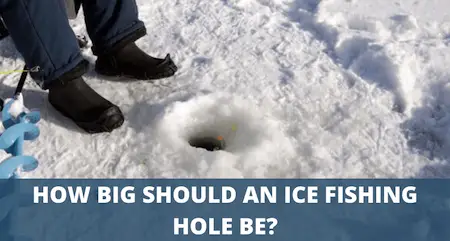How To Choose The Best Ice Fishing Hole Size
UPDATED 18 MAY 2023
by Robert Ceran
Are you wondering what size hole you need for ice fishing?
The optimal size of an ice fishing hole depends on the size of the fish you are planning to catch.
Most crappies easily fit through a 5 inch hole, while a 25 pound pike requires an 8 inch hole in order to be pulled through the ice without problems.
In general, a 6 inch hole is fine for small fish (such as panfish), an 8 inch hole is ideal for medium sized fish (such as pike), and a 10 inch hole is best for large fish (such as muskie).

Which hole size is best for different fish species?
The size of the ice auger you use to drill a hole determines its size, which is why you need to choose the correct auger size before you go fishing.
Ice fishing holes range from 4 to 12 inches in diameter, and the best size to choose depends on the size of fish you’ll be catching. Below we’ve summarized the optimal size for different species:
| Fish species | Optimal hole size |
|---|---|
| Crappie, Perch, Bluegill | 5-6 inches |
| Northern Pike, Walleye, Lake Trout, Whitefish, Bass | 8 inches |
| Muskie | 10 inches |
| Flathead Catfish | 12 inches |
Table 1: Optimal ice fishing hole size for different fish species.
Hole size is defined by its diameter, but you need to keep in mind that the circumference of the hole must be large enough to accommodate the girth of the fish you want to catch. The circumference is calculated by multiplying its diameter by 3.14.
Here’s a list of the circumferences of common ice fishing hole sizes:
| Hole diameter | Hole circumference |
|---|---|
| 6 inches | 19 inches |
| 8 inches | 25 inches |
| 10 inches | 31 inches |
Table 2: Ice hole diameter compared with circumference
Best ice fishing hole size for crappie and other panfish
If you’re a fan of fishing for smaller fish (perch, crappies, and bluegills), then a 6 inch hole is plenty big for most fish you’ll catch, except the very largest slab crappies.
Many panfish and perch anglers happily use a 5 inch ice auger, and never have any problems with fish being too large to fit through the opening.
If you’re worried you could hook a large walleye or pike while fishing for panfish, go for an 8 inch hole instead.
An 8 inch hole is big enough for 99% of the fish you could possibly expect to catch on most lakes.
But remember that the hook sometimes gets loose when a crappie comes out of the ice.
n a 6 inch hole the crappies have a hard time turning around, so you can quickly grab them if that happens, but that doesn’t work in an 8 inch hole.
Also, if a fish does turn out to be too big for your opening, you can always enlarge the hole by drilling a second one next to it, and then removing the ice in between them with an ice spud. This more than doubles its size.
Best ice fishing hole size for large fish
The 31 pound northern pike I caught a couple of years ago (my personal best) had a girth of 23 inches.
That size still fits through an 8 inch hole (which has a circumference of 25 inches), though it’s a bit of a tight fit.
However, a 50 pound muskie can have a girth of 28 inches, and clearly that won’t fit through an 8 inch hole.
You’ll need a 10 inch hole to pull a muskie of that size through the ice. Trophy sized lake trout can also reach similar sizes, and require a 10 inch opening.
If you’re using tip ups in really cold temperatures, you need to keep in mind that the holes will freeze over again fairly quickly.
Because of this, you need to reopen them with an ice spud from time to time, but even then the hole diameter gets smaller with time.
Flathead catfish get even bigger than muskie, and reach a girth size of more than 30 inches, so you’ll need a 12 inch hole if you’re going to catch fish of this size.
If you’re worried that your opening might be too small, you can drill several holes right next to each other, and then break down the remaining ice between them with a shovel or ice spud.
If you’re fishing together with a buddy, you can start fishing with a single opening, and then ask your friend to drill an additional hole if you hook a big fish.
What hole size to choose if you’re using a flasher
If you’re using a flasher or fish finder with an ice fishing transducer, then the transducer needs to fit inside the same opening that you’re using to catch fish. Ice transducers are usually suspended in the water with a sliding float.
You should choose a hole size that comfortably allows you to pull out fish without having to remove the transducer every time, so choose an ice auger size that’s about 1 inch larger than what you would normally use.
Flashers are great for catching more fish through ice – for more information on this check out our review on the top ice fishing flashers.
Also, if you’re using an Aqua-Vu or Marcum underwater camera, it’s best to use a separate hole that should be about 6 inches big.
Manual vs. gas ice augers and hole size
Are you using a manually operated ice auger, or one that runs on gas? Many anglers prefer to use manual ice augers, since they are a lot lighter, as well as cheaper. However, the downside of manual ice augers is that drilling holes with them requires a lot of energy.
This may not strike you as significant, but believe me, when you’ve drilled 10 holes or more through thick ice, that really tires you out.
Ice fishing often involves moving around a lot until you find the right fishing spot, and that just requires drilling many holes, and packing up and moving on to the next one if you don’t get any bites.
The thing you need to keep in mind here is that bigger ice augers require more energy to operate than small ones. So if you’re using a manual ice auger and you plan to move around a lot, you’ll probably want to choose the smallest size possible for your purposes.
Ice thickness and hole size
Thin ice in early winter makes it easier to drill a hole, so using a large manual ice auger is no problem at this stage.
But as winter progresses, the ice can get much thicker, and this makes your drilling work much harder. Manually drilling an 8 inch hole in 2 feet of ice is hard work, and remember that you might have to do this several times before you find fish.
When the ice gets really thick in late winter, either switch to using a gas auger, or try to go with the smallest size you can get away with.
But if you’re trying to keep the size small, remember that a big fish can chafe your ice fishing line on the bottom edge of the ice fishing hole, which can lead to damage and even line breakage. This is easier to avoid with a large hole diameter.
So if you’re expecting big fish in late winter, it’s probably best to go with a gas auger, so you can make sure to drill sufficiently large openings.
A great trick you can use to avoid drilling many holes in vain is to use a fish finder to shoot sonar through the intact ice, which allows you to detect fish under the ice without having to drill with an auger.
That way you can make sure there are fish present before you exert yourself and start drilling (for more details on this, check out our article can a fish finder work through ice).
Best Ice fishing hole size for shallow water
If you’re fishing for crappie in shallow water of 6 feet or less, then try to use the smallest auger size possible.
The reason for this is that a large opening allows more light to enter the water, which can scare away the fish.
Especially with thick ice that has snow on top of it, the crappies are used to being in very dimly lit conditions, and bright light coming in through a big opening will startle them.
So if you want to do shallow water ice fishing, choose a 4 inch or 5 inch auger.
But keep in mind that small holes freeze over again faster than big ones, so you may have to open them again during the day.
When fishing shallow water, you should also space your holes at least 10 feet apart for the same reason – so you don’t flood the whole area with light coming through the openings (for more details on this, check out our article on how far apart should ice fishing holes be).
